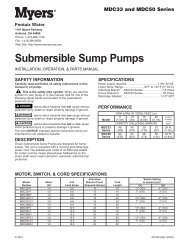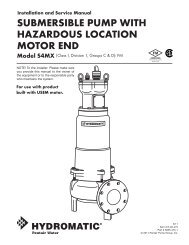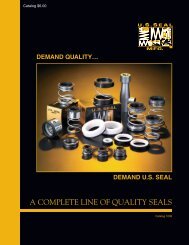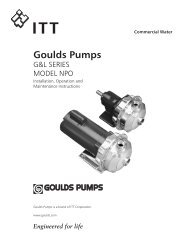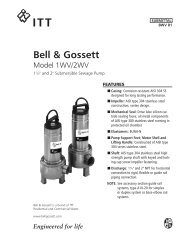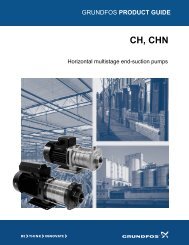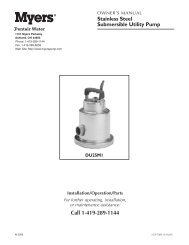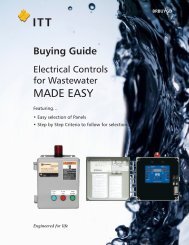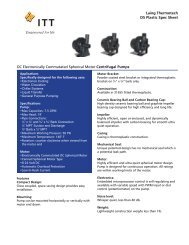Submersible Sewage Ejector Pump - Sump Pumps
Submersible Sewage Ejector Pump - Sump Pumps
Submersible Sewage Ejector Pump - Sump Pumps
You also want an ePaper? Increase the reach of your titles
YUMPU automatically turns print PDFs into web optimized ePapers that Google loves.
12.To ensure that the pump is<br />
properly installed, fill basin<br />
with enough water to activate<br />
pump. Allow the pump to go<br />
through several on-off cycles<br />
to assure satisfactory operation.<br />
13.Use pump partially or<br />
completely submerged for<br />
pumping waterlike liquids<br />
(temperature to 140° F).<br />
The SKV50 will pump solid<br />
materials up to 2" (spherical)<br />
in diameter.<br />
Caution: Do not pump<br />
flammable liquids, strong<br />
chemicals or salt water.<br />
Your pump warranty is void...<br />
If...power cord has been cut.<br />
If...pump has been used to<br />
pump mud, cement, tar,<br />
abrasives or chemicals.<br />
If...pump has been used for<br />
pumping of hot water<br />
(above 120° F).<br />
If...pump has been dismantled<br />
by other than authorized<br />
Hydromatic service center<br />
or distributor.<br />
<strong>Pump</strong><br />
Servicing<br />
Read the following instructions<br />
carefully before replacing any<br />
parts. Reasonable care and safe<br />
methods should be practiced.<br />
Check local codes and<br />
requirements before installation.<br />
Only competent electrician<br />
should make the installations.<br />
The following steps should be<br />
performed by an authorized<br />
Hydromatic service center<br />
or distributor.<br />
Note: Use extreme caution<br />
around electrical devices.<br />
Electrical shock may occur.<br />
1. Before removing pump from<br />
the sump, check to be sure the<br />
problem is not a blown fuse,<br />
tripped circuit breaker or a<br />
power cord not completely<br />
inserted into the receptacle.<br />
2. If the unit is being operated by<br />
an optional control switch,<br />
unplug the pump from the<br />
piggyback receptacle and plug<br />
the pump directly into the<br />
power source. If the pump<br />
starts each time it is plugged<br />
directly into the receptacle and<br />
does not start each time when<br />
plugged into the piggyback<br />
switch with the float raised or<br />
diaphragm pressed up to a start<br />
position, replace the complete<br />
switch assembly and retest<br />
with new assembly.<br />
3. If pump fails the above two<br />
steps, remove pump and<br />
switch from power source to<br />
avoid electrical shock. Then<br />
pull the pump from the sump<br />
by the handle. Sandblast, if<br />
possible, any dirt or trash<br />
from the outside of the pump<br />
before dismantling.<br />
4. If the above tests have not<br />
resolved the problem, it may<br />
be in the electrical components<br />
of the pump. Starting with the<br />
power cord, inspect for cuts or<br />
nicks in the insulation. If the<br />
cord is damaged – replace it!<br />
5. Using the ohmmeter, check<br />
the resistance of the motor<br />
windings by connecting one<br />
lead clip to each electrical<br />
“flat” prong on the power cord<br />
3



